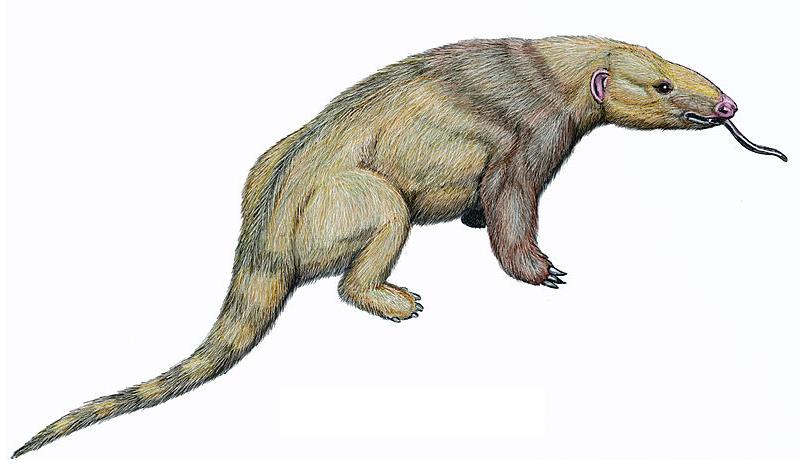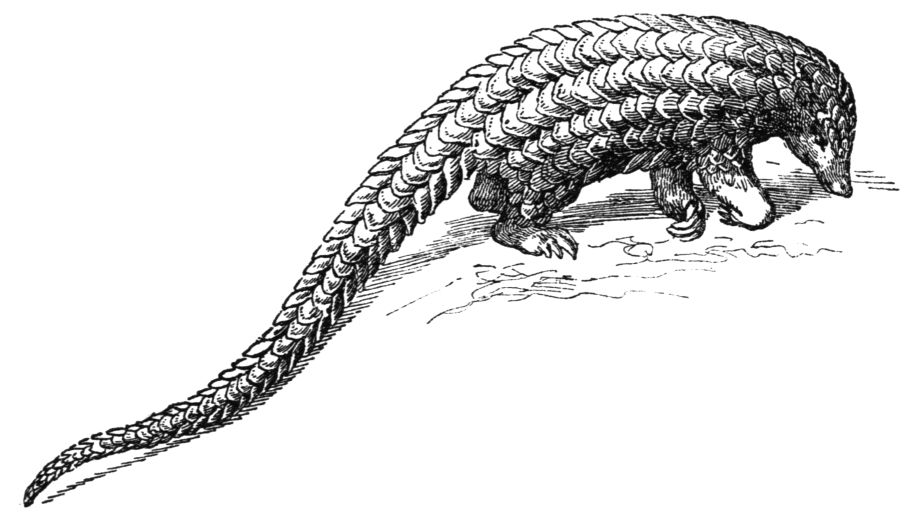|
Manidae
Manidae is the only extant family of pangolins from superfamily Manoidea. This family comprises three genera (''Manis'' from subfamily Maninae, '' Phataginus'' from subfamily Phatagininae, and '' Smutsia'' from subfamily Smutsiinae), as well as extinct Fayum pangolin. Classification and phylogeny History of classification All species of living pangolin had been assigned to the genus ''Manis'' until the late 2000s, when research prompted the splitting of extant pangolins into three genera: ''Manis'', '' Phataginus'', and '' Smutsia''. Taxonomy * Family: Manidae (pangolins) ** Subfamily: Maninae (Gray, 1821) *** Genus: ''Manis'' (Linnaeus, 1758) (Asiatic pangolins) **** ''Manis crassicaudata'' (Gray, 1827) (Indian pangolin) **** '' Manis pentadactyla'' (Linnaeus, 1758) (Chinese pangolin) **** ''Manis'' sp. (''Scale_H4'' & ''Scale_H8'')Jingyang Hu, Christian Roos, Xue Lv, Weimin Kuang, Li Yu (2020."Molecular Genetics Supports a Potential Fifth Asian Pangolin Species (Mammali ... [...More Info...] [...Related Items...] OR: [Wikipedia] [Google] [Baidu] |
Pangolin
Pangolins, sometimes known as scaly anteaters, are mammals of the order Pholidota (, from Ancient Greek ϕολιδωτός – "clad in scales"). The one extant family, the Manidae, has three genera: ''Manis'', '' Phataginus'', and '' Smutsia''. ''Manis'' comprises the four species found in Asia, while ''Phataginus'' and ''Smutsia'' include two species each, all found in sub-Saharan Africa. These species range in size from . A number of extinct pangolin species are also known. Pangolins have large, protective keratin scales, similar in material to fingernails and toenails, covering their skin; they are the only known mammals with this feature. They live in hollow trees or burrows, depending on the species. Pangolins are nocturnal, and their diet consists of mainly ants and termites, which they capture using their long tongues. They tend to be solitary animals, meeting only to mate and produce a litter of one to three offspring, which they raise for about two years. Pangol ... [...More Info...] [...Related Items...] OR: [Wikipedia] [Google] [Baidu] |
Manoidea
Manoidea is a superfamily of pangolins from suborder Eupholidota that includes extant family Manidae, extinct family Patriomanidae and extinct genus '' Necromanis''. Taxonomy * Superfamily: Manoidea ** Family: Manidae (pangolins) ** Family: †Patriomanidae ** ''Incertae sedis ' () or ''problematica'' is a term used for a taxonomic group where its broader relationships are unknown or undefined. Alternatively, such groups are frequently referred to as "enigmatic taxa". In the system of open nomenclature, uncertain ...'' *** Genus: †'' Necromanis'' Phylogeny Phylogenetic position of superfamily Manoidea within suborder Eupholidota. References Pangolins Mammal superfamilies {{mammal-stub ... [...More Info...] [...Related Items...] OR: [Wikipedia] [Google] [Baidu] |
Phataginus
African tree pangolin (''Phataginus'') is a genus of African pangolins from subfamily small African pangolins (Phatagininae), within family Manidae. Its members are the more arboreal of the African pangolins. The number of illegally trafficked pangolins from genus ''Phataginus'' were at least a shocking 895,000 from the years 2010 to 2019. The animal is hunted and poached for its scales and meat and is often used for the making of traditional medicine in places such as China and Vietnam. Attempts are still being made to help protect these mammals from trafficking and extinction, unfortunately their slow reproduction rate isn't much of assistance to this effort. Currently the tree pangolin is listed as vulnerable. All of the pangolins species have been listed as vulnerable, endangered and critically endangered.Gaubert, P. (2020). "Development and characterization of 20 polymorphic microsatellite markers for the white-bellied pangolin ''Phataginus tricuspis'' (Mammalia, Pholidota ... [...More Info...] [...Related Items...] OR: [Wikipedia] [Google] [Baidu] |
Manis Hungarica
''Manis'' is a genus of South Asian and East Asian pangolins, the Asiatic pangolins, from subfamily Maninae, within family Manidae. Etymology Carl Linnaeus (1758) invented the Neo-Latin generic name ''Manis'' apparently as a feminine singular form of the Latin masculine plural Manes, the Ancient Roman name for a type of spirit, after the animal's strange appearance. Taxonomy * Subfamily: Maninae (Asiatic pangolins) ** Genus: ''Manis'' (Asiatic pangolins) *** ''Manis crassicaudata'' (Indian pangolin) *** ''Manis pentadactyla'' (Chinese pangolin) *** ''Manis'' sp. (Scale_H4 & Scale_H8)Huarong Zhang, Mark P. Miller, Feng Yang, Hon Ki Chan, Philippe Gaubert, Gary Ades, Gunter A. Fischer (2015."Molecular tracing of confiscated pangolin scales for conservation and illegal trade monitoring in Southeast Asia" Global Ecology and Conservation, Volume 4, Pages 414-422Jingyang Hu, Christian Roos, Xue Lv, Weimin Kuang, Li Yu (2020."Molecular Genetics Supports a Potential Fifth Asian Pangol ... [...More Info...] [...Related Items...] OR: [Wikipedia] [Google] [Baidu] |
Paramanis
''Manis'' is a genus of South Asian and East Asian pangolins, the Asiatic pangolins, from subfamily Maninae, within family Manidae. Etymology Carl Linnaeus (1758) invented the Neo-Latin generic name ''Manis'' apparently as a feminine singular form of the Latin masculine plural Manes, the Ancient Roman name for a type of spirit, after the animal's strange appearance. Taxonomy * Subfamily: Maninae (Asiatic pangolins) ** Genus: ''Manis'' (Asiatic pangolins) *** ''Manis crassicaudata'' (Indian pangolin) *** '' Manis pentadactyla'' (Chinese pangolin) *** ''Manis'' sp. (Scale_H4 & Scale_H8)Huarong Zhang, Mark P. Miller, Feng Yang, Hon Ki Chan, Philippe Gaubert, Gary Ades, Gunter A. Fischer (2015."Molecular tracing of confiscated pangolin scales for conservation and illegal trade monitoring in Southeast Asia" Global Ecology and Conservation, Volume 4, Pages 414-422Jingyang Hu, Christian Roos, Xue Lv, Weimin Kuang, Li Yu (2020."Molecular Genetics Supports a Potential Fifth Asian Pang ... [...More Info...] [...Related Items...] OR: [Wikipedia] [Google] [Baidu] |
Manis
''Manis'' is a genus of South Asian and East Asian pangolins, the Asiatic pangolins, from subfamily Maninae, within family Manidae. Etymology Carl Linnaeus (1758) invented the Neo-Latin generic name ''Manis'' apparently as a feminine singular form of the Latin masculine plural Manes, the Ancient Roman name for a type of spirit, after the animal's strange appearance. Taxonomy * Subfamily: Maninae (Asiatic pangolins) ** Genus: ''Manis'' (Asiatic pangolins) *** ''Manis crassicaudata'' (Indian pangolin) *** ''Manis pentadactyla'' (Chinese pangolin) *** ''Manis'' sp. (Scale_H4 & Scale_H8)Huarong Zhang, Mark P. Miller, Feng Yang, Hon Ki Chan, Philippe Gaubert, Gary Ades, Gunter A. Fischer (2015."Molecular tracing of confiscated pangolin scales for conservation and illegal trade monitoring in Southeast Asia" Global Ecology and Conservation, Volume 4, Pages 414-422Jingyang Hu, Christian Roos, Xue Lv, Weimin Kuang, Li Yu (2020."Molecular Genetics Supports a Potential Fifth Asian Pangol ... [...More Info...] [...Related Items...] OR: [Wikipedia] [Google] [Baidu] |
Smutsia
''Smutsia'' is a genus of African pangolins, better known as the African ground pangolins, from subfamily Smutsiinae, within family Manidae. It was formerly considered a subgenus of ''Manis''. Its members are the more terrestrial of the African pangolins. Etymology British naturalist John Edward Gray named ''Smutsia'' for South African naturalist Johannes Smuts (1808–1869), the first South African to write a treatise A treatise is a formal and systematic written discourse on some subject, generally longer and treating it in greater depth than an essay, and more concerned with investigating or exposing the principles of the subject and its conclusions." Treat ... on mammals in 1832 (in which he described the species ''Manis temminckii''). Taxonomy * Subfamily: Smutsiinae (large African pangolins) ** Genus: ''Smutsia'' (African ground pangolin) *** '' Smutsia gigantea'' (giant pangolin) *** '' Smutsia temminckii'' (ground pangolin) *** †'' Smutsia olteniensis'' Phylogeny ... [...More Info...] [...Related Items...] OR: [Wikipedia] [Google] [Baidu] |
Manis Palaeojavanica
Giant asian pangolin (''Manis palaeojavanica'' ancient Javan pangolin", is an extinct species of pangolin (from genus ''Manis'') that was native to Asia. In 1926, E. Dubois described the bones of ''M. palaeojavanica'' discovered in Java. Later, Lord Medway excavated another set of bones at the Niah Caves in Malaysia. In 1960, D. A. Hoojier identified these bones as that of an extinct species. Using carbon dating, the Niah Caves bones were determined to be 42,000–47,000 years old. ''M. palaeojavanica'' is one of the only known fossils to be found nearly complete of the pangolin species, due to their armour-like scales that protected their bodies when they were alive. Its total length is measured up to .Hooijer, D.A., 1947 - A femur of ''Manis palaeojavanica'' Dubois from Western Java - Proceedings of the Koninklijke Nederlandsche Akademie van Wetenschappen 50 (4): 423-418 Phylogeny Phylogenetic position of ''Manis palaeojavanica'' within family Manidae.Philippe Gaubert, Agos ... [...More Info...] [...Related Items...] OR: [Wikipedia] [Google] [Baidu] |
Manis Crassicaudata
The Indian pangolin (''Manis crassicaudata''), also called thick-tailed pangolin and scaly anteater is a pangolin native to the Indian subcontinent. Like other pangolins, it has large, overlapping scales on its body which act as armour. The colour of its scales varies depending on the colour of the earth in its surroundings. It can also curl itself into a ball as self-defence against predators such as the tiger. It is an insectivore feeding on ants and termites, digging them out of mounds and logs using its long claws, which are as long as its fore limbs. It is nocturnal and rests in deep burrows during the day. It is not common anywhere in its range, and is threatened by hunting for its meat and for various body parts used in traditional medicine. Characteristics The Indian pangolin is a solitary, shy, slow-moving, nocturnal mammal. It is about long from head to tail, the tail usually being long, and weighs . Females are generally smaller than the males and have one pair o ... [...More Info...] [...Related Items...] OR: [Wikipedia] [Google] [Baidu] |
Long-tailed Pangolin
The long-tailed pangolin (''Phataginus tetradactyla''), also called the African black-bellied pangolin, or ''ipi'', is a diurnal, arboreal pangolin species belonging to the family Manidae, in the order Pholidota. They feed on ants rather than termites. The common names for this species stem from physical characteristics, such as the extremely long tail or the dark hairs that cover the underside of their bodies and limbs. Pangolin comes from the Malay word ''pengguling'', meaning “something that rolls up”. Description ''Phataginus tetradactyla'' has a characteristic very long tail (hence its common name), reaching a length around . The tail contains 46–47 caudal vertebrae, a record among mammals. The body can reach a length of and weigh 2.0–2.5 kg. The males are larger than the females. Even with the long tail, this species is the smallest of eight extant species of pangolins. As with other pangolins, the long-tailed pangolin is covered with 9 to 13 rows of overla ... [...More Info...] [...Related Items...] OR: [Wikipedia] [Google] [Baidu] |
Indian Pangolin
The Indian pangolin (''Manis crassicaudata''), also called thick-tailed pangolin and scaly anteater is a pangolin native to the Indian subcontinent. Like other pangolins, it has large, overlapping scales on its body which act as armour. The colour of its scales varies depending on the colour of the earth in its surroundings. It can also curl itself into a ball as self-defence against predators such as the tiger. It is an insectivore feeding on ants and termites, digging them out of mounds and logs using its long claws, which are as long as its fore limbs. It is nocturnal and rests in deep burrows during the day. It is not common anywhere in its range, and is threatened by hunting for its meat and for various body parts used in traditional medicine. Characteristics The Indian pangolin is a solitary, shy, slow-moving, nocturnal mammal. It is about long from head to tail, the tail usually being long, and weighs . Females are generally smaller than the males and have one pair ... [...More Info...] [...Related Items...] OR: [Wikipedia] [Google] [Baidu] |

.jpg)
.jpg)
